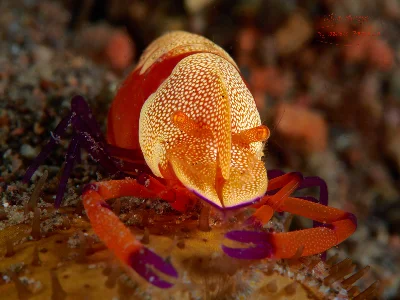Emperor Shrimp
Zenopontonia rex
Zenopontonia rex, commonly known as the emperor shrimp or imperial shrimp, is a captivating marine creature belonging to the Palaemonidae family. This eye-catching shrimp is found in the warm, shallow waters of the tropical Indo-Pacific region, from the 🌊 Red Sea and Réunion to Hawaii (🇺🇸 United States) and 🇵🇫 French Polynesia, and from southern 🇯🇵 Japan to 🇳🇨 New Caledonia (🇫🇷 Overseas France) and northern 🇦🇺 Australia. It inhabits coral reefs and sandy ocean floors, residing primarily at depths of up to 40 meters (130 feet).
Characterized by its striking appearance, the emperor shrimp grows to a length of about 3 centimeters (1.2 inches), with females being slightly larger yet less colorful. Its robust body features a series of plate-like antennae extending forward from the head, a smooth-looking rostrum with tiny spines, and a cephalothorax adorned with small spines on each side. The first two pairs of legs are equipped with pincers and short sensory hairs.
The shrimp's basic color palette ranges from orange-yellow to orange-red, accentuated by purple antennal plates, claws, and walking legs. Throughout the day, white chromatophores in their skin expand, often creating a striking dorsal pattern or median band, while leaving the rest of their orange color exposed. This coloration notably varies with its host, typically maintaining a classic pattern when associated with sea cucumbers, though it can adapt to match the hues of other host organisms like nudibranchs.
Living symbiotically with a variety of hosts, the emperor shrimp thrives alongside sea cucumbers from genera such as Bohadschia, Opheodesoma, Stichopus, Synapta maculata, and Thelenota. It also partners with nudibranchs and other large molluscs, including Asteronotus, Ceratosoma, Chromodoris, Cypraea, Dendrodoris, Hexabranchus, Hypselodoris, and Pleurobranchus, and, occasionally, starfish like Eundefinedster or Gomophia. Often, two or even three shrimps can share a single host, typically sporting identical coloring as they cling to the dorsal surface or flanks, ready to evade potential threats by moving to the far side of their host.
Zenopontonia rex primarily subsists on debris found on the seabed and maintains its host by cleaning their surface and feeding on mucus and excrement. As a species, this shrimp is gonochoric, meaning individuals have distinct male and female sex characteristics. Males use their first two pairs of walking legs to deposit sperm onto the underside of the female’s thorax, where she carries her eggs until they hatch into planktonic larvae, continuing the shrimp's life cycle.
Comments
Please, sign in to leave comment
No Comments yet
Last Update: May 28, 2025

